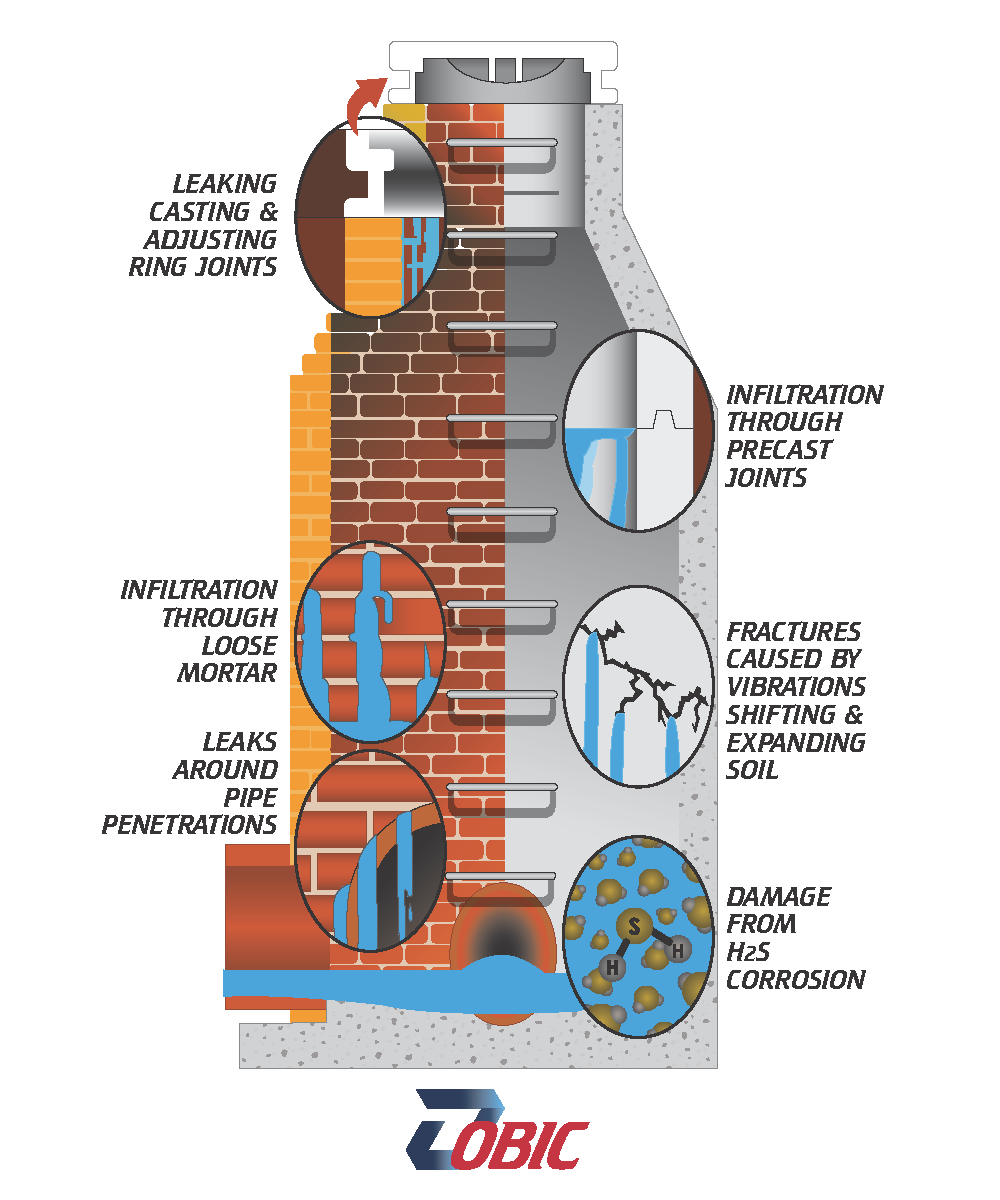How to Treat Manhole Inflow and Infiltration Issues Fast
We all know infiltration when we see it – you open the manhole cover and there’s seeping water or maybe even rushing water. This groundwater is leaking into the system and ends up at the wastewater treatment plant, causing operational inefficiencies and higher costs for the community. So when you do see it, you need to know what is causing it and how to treat it FAST. We thought it would be a nice refresher to easily show the six main types of I&I in this illustration and how we’ve fixed these for clients:

Leaking Casting and Adjusting Ring Joints
Manhole frames and covers or adjusting rings are installed to the cone section of the manhole with cement mortar. Because it is at the top near ground level, it’s exposed to freeze/thaw cycles, heavy vehicle loading, traffic vibration, and sometimes earth movement. All of these can cause the mortar to crack, creating voids with groundwater or rainwater infiltration.
OBIC’s line of manhole lining systems and sewer lining coatings are made of a flexible polymer that is spray applied and cures in minutes. This completely seals the mounting joint and any stacked adjusting rings and provides a watertight fix to the infiltration problem. The flexible properties of the OBIC lining resist movement caused by freeze/thaw cycles, vibrations and soil movement, and it won’t come loose like other internal mechanical seals. In addition, the OBIC system does not require excavation, but external seals will require it. Watch this video to follow along step-by-step with a project in Moscow, Idaho as they prepare and line a manhole with OBIC products.
Infiltration Through Pre-cast Joints
In order to comply with ASTM C478, pre-cast manhole sections are fitted with gasket material to provide a watertight joint that inhibits infiltration through the joint. Over time, the gasket material degrades, stretches, washes out, or otherwise fails to prevent groundwater infiltration.
Menallen Township had approximately 20 sewage manholes that were in various stages of deterioration. The OBIC manhole lining system was installed, extending the life of the manholes substantially. They were able to completely eliminate all stormwater infiltration into the sewage system, so treatment plants were no longer overloaded. Read full case study here
Infiltration Through Loose Mortar
Hydrogen sulfide gas corrosion, freeze/thaw cycles, traffic loading, and ground movement can all cause mortar joints to fail.
Similar to many municipalities across the country, Bay City’s manhole structures were made of brick, block and precast structures that varied in age. Over time, in some cases more than 50 years, leaks and deterioration began to jeopardize their structural integrity. In an effort to address these issues quickly and efficiently, an OBIC-certified installer was called in to rehabilitate 170 of the city’s aging manholes. Read full case study here
Leaks Around Pipe Penetrations
Typical pipe penetrations in a manhole are the sewer line at the bottom or a drain pipe that was installed with the manhole, or more likely, at a later date resulting in a substrate penetration. These penetrations are sealed with cement mortar that eventually cracks or deteriorates allowing groundwater to infiltrate.
Rostraver Township Sewage Authority in Westmoreland County, Pennsylvania, was struggling with finding solutions for an aging sewer system. The Township Authority was so impressed with the performance of OBIC products that they are already looking at future projects. Read full case study here
Fractures Caused by Vibrations, Shifting and Expanding Soil
Damage during installation/transportation of the components, ground movement, earthquakes, and vehicle traffic can cause vibrations that may result in structure cracking over time.
Advanced Rehabilitation Technology (ART), an OBIC-certified installer, was featured in Inflow & Infiltration Solutions and Equipment (I&I) magazine for a successful manhole rehab project done for the city of Parkersburg, West Virginia. In the article, “What Lies Beneath”, hidden I&I had set a major sinkhole event into action and ART quickly went to work using OBIC 1000, a fast-curing polyurea coating, and OBIC 1306, a high-density polyurethane foam to repair, rehabilitate, and restore the manhole fast. Learn more about this project.
Damage From H2S Corrosion
Hydrogen-sulfide corrosion occurs as an acid attack caused by the chemical/biological conversion of hydrogen-sulfide gas to sulfuric acid when moisture is present. When that highly corrosive sulfuric acid runs down the wall of a concrete manhole over time, it will begin to erode the concrete surface and eventually erode several inches of thickness and lessen the structural integrity.
Memphis, Tenn., ran into a particular infrastructure rehabilitation challenge when a run of 15-inch VCP sewer main with eight manholes was compromised by age and H2S gas. The chosen structural solution—OBIC Armor 1000—used a three-layer installation process, requiring all active leaks stopped before application. It was chosen for its structural enhancement, protective properties, quick application and return-to-service. Read full case study here
There are dozens of challenges facing sewer system owners, but there is one solution that can resolve all of them. OBIC lining systems are versatile enough to rehabilitate and protect sewer manholes of every construction material, shape, size, and age. To learn more about how OBIC products can rehabilitate even the most difficult water or wastewater rehabilitation issues, call us at 866-636-4854.
